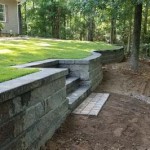How To Build A Stone Patio On Grass: A Comprehensive Guide
Building a stone patio on grass offers a beautiful and functional outdoor living space. This project, while manageable for experienced DIY enthusiasts, requires careful planning, meticulous execution, and a good understanding of basic landscaping principles. This article details the process, from initial planning to final installation, providing a comprehensive guide for creating a durable and aesthetically pleasing stone patio directly on a grassy area.
Before commencing any physical work, a detailed plan is crucial. This initial phase involves assessing the site, selecting the appropriate materials, and accurately calculating the quantities required. Neglecting this preparatory stage can lead to costly errors and delays later in the project.
Phase 1: Planning and Preparation
The first step within the planning stage is site assessment. Evaluate the existing topography of the grassy area. Is it level, or does it have a noticeable slope? Consider the drainage patterns; where does water naturally flow after rainfall? Addressing drainage issues is paramount to prevent water pooling under the patio, which can lead to instability and material degradation over time. If significant grading is necessary, consider consulting with a landscape professional.
Next, determine the size and shape of the intended patio. Sketch out the desired dimensions on paper, taking into account the available space and the intended use of the patio. Will it primarily serve as a dining area? Will it accommodate a lounging area with furniture? Considering these factors will influence the optimal size and shape of the patio. Mark the outline of the patio on the grass using stakes and string. This will provide a visual representation of the project's boundaries and assist with accurate measurements.
Material selection is another critical aspect of planning. The choice of stone will significantly impact the overall aesthetic and durability of the patio. Common options include flagstone, pavers, and cobblestones, each offering unique characteristics in terms of appearance, texture, and cost. Flagstone, with its irregular shapes and natural variations, provides a rustic and organic look. Pavers, manufactured stones available in various sizes and colors, offer a more uniform and contemporary appearance. Cobblestones, small rounded stones, create a charming and historic feel. Research the properties of each material and select the option that best aligns with the desired aesthetic and budget.
Once the stone type is selected, calculate the quantity needed based on the patio's dimensions. It's generally recommended to purchase 5-10% extra material to account for cuts, breakage, and potential variations in size. In addition to the stone, other essential materials include landscape fabric, crushed gravel (typically ¾ inch minus), leveling sand, and joint sand. Landscape fabric prevents weed growth from penetrating the patio. Crushed gravel provides a stable base for the stone, ensuring proper drainage. Leveling sand creates a smooth and even surface for setting the stones. Joint sand fills the gaps between the stones, providing stability and preventing weed growth.
Finally, gather the necessary tools for the project. Essential tools include a shovel, wheelbarrow, tamper, level, measuring tape, rubber mallet, utility knife, and safety glasses. A plate compactor or a hand tamper will be needed to compact the gravel base. A circular saw or a brick hammer may be required for cutting stones to fit irregular shapes.
Phase 2: Excavation and Base Preparation
With the planning phase complete, the actual construction process can commence. The initial step involves excavating the grassy area within the marked boundaries. The depth of excavation will depend on the thickness of the stone and the desired thickness of the gravel base. A general guideline is to excavate to a depth of approximately 6-8 inches. This allows for a 4-inch gravel base, a 1-inch sand layer, and the thickness of the stone itself. Use a shovel to carefully remove the grass and topsoil within the marked area. Ensure the excavation is uniform in depth to create a consistent base for the patio.
Once the excavation is complete, compact the exposed soil using a hand tamper or a plate compactor. This will create a firm and stable foundation for the gravel base. Compaction is crucial to prevent settling and shifting of the patio over time. Pay particular attention to the edges of the excavation, ensuring they are well compacted to prevent erosion.
Next, install the landscape fabric over the compacted soil. Overlap the edges of the fabric by several inches to prevent weed growth from penetrating the patio. The landscape fabric acts as a barrier, inhibiting weed growth and preventing the gravel base from mixing with the underlying soil. Secure the fabric to the ground using landscape staples to prevent it from shifting during the gravel installation process.
Pour the crushed gravel into the excavated area, spreading it evenly to a depth of approximately 4 inches. Use a shovel or rake to distribute the gravel uniformly. Compacting the gravel base is perhaps the most vital step in ensuring the long-term stability of the patio. Use a plate compactor to thoroughly compact the gravel, making multiple passes over the entire area. This will create a dense and solid base that will support the weight of the stone and prevent settling. A hand tamper can be used for smaller patios or areas where a plate compactor is difficult to maneuver.
After compacting the gravel, use a level to check for any unevenness. Add or remove gravel as needed to create a perfectly level surface. A slight slope (approximately 1/4 inch per foot) away from the house is recommended to facilitate proper drainage. This slight slope will prevent water from pooling on the patio surface and directing it away from the foundation of the house.
Phase 3: Stone Placement and Joint Filling
With the gravel base prepared, the next step is to add a layer of leveling sand. Spread a layer of leveling sand approximately 1 inch thick over the compacted gravel base. Use a rake or a screed board to evenly distribute the sand, creating a smooth and level surface for setting the stones. The sand layer should be uniform in thickness to ensure that the stones are evenly supported. Compacting the sand is not necessary; it should remain loose to allow for minor adjustments during stone placement.
Begin placing the stones according to the desired pattern. If using flagstone, with its irregular shapes, arrange the stones in a way that minimizes large gaps and creates a visually appealing pattern. If using pavers, follow the manufacturer's recommendations for the specific pattern. When using cobblestones, consider creating a fan or circular pattern for added visual interest. Gently press each stone into the sand layer, using a rubber mallet to tap it firmly into place. Check the level of each stone using a level, making adjustments to the sand layer as needed to ensure that all stones are flush with each other.
Maintain a consistent spacing between the stones to create joints. The width of the joints will depend on the size and type of stone, but a general guideline is to maintain joints between ½ inch and 1 inch wide. These joints will be filled with joint sand to provide stability and prevent weed growth. As you place the stones, use a utility knife to cut landscape fabric to fit around the edges of the patio. This will prevent weeds from growing up between the stones and the surrounding grass.
Once all the stones are in place, thoroughly sweep the patio surface to remove any debris or sand. Next, spread joint sand over the patio, filling the gaps between the stones. Use a broom to work the sand into the joints, ensuring that they are completely filled. The joint sand will provide stability to the stones and prevent weed growth. After filling the joints, use a fine spray of water to settle the sand. Be careful not to overwater, as this can wash away the sand. Allow the patio to dry completely before walking on it.
Periodically check the patio for any settling or shifting of the stones. If any stones become loose, remove them, add more sand to the base, and reset the stones. Regularly sweep the patio to remove debris and prevent weed growth. Consider applying a sealant to the stone to protect it from staining and weathering. A sealant will also enhance the color of the stone and make it easier to clean.
Building a stone patio on grass is a rewarding project that can significantly enhance the value and enjoyment of a home. By following these steps and taking the time to plan and execute the project carefully, a durable and aesthetically pleasing outdoor living space can be created.

Diy Patio With Grass Between Pavers And A Fire Pit

Diy Patio With Grass Between Pavers And A Fire Pit

Diy Patio With Grass Between Pavers And A Fire Pit

Diy Patio With Grass Between Pavers And A Fire Pit

Diy Patio With Grass Between Pavers And A Fire Pit

How To Make A Stepping Stone Walkway Lowe S

Diy Paver Artificial Turf Patio

How To Build A Pea Gravel Patio Farmhouse On Boone

How To Lay A Flagstone Walkway In An Existing Lawn

Diy Patio With Grass Between Pavers And A Fire Pit Backyard Paver
Related Posts








